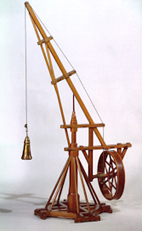
152.4 x 51.4 x 77.5
Wood and brass
INDEX 1788 : E.III.138
Axis in peritrochio cum magno rostro Gruis instar, unde Gallice Grue appellatur.
Axle in a wheel, with a long pointed 'beak' like a crane; hence it is called in French 'grue' (crane).
Desaguliers refers to this machine as "rat's tail crane". The example in the University's Gabinete de Física is a model of a crane used for lifting and moving around very heavy loads by rotating around a vertical axis. This axis is at the top of a wooden column supported by eight wooden beams arranged in the shape of a square pyramid. The lower ends of the beams are attached to four horizontal supports forming a cross which are meant to rest on a solid floor.
A rope attached to a reel passes through four fixed pulleys along the wooden arm of the crane. Power is supplied by someone walking on the steps inside a treadmill: this rotary movement causes the rope to wind round the reel to the axle of the treadmill, thereby raising a load tied to the end of the rope. On the outer side of the treadmill a second rope is wound, to be pulled by another man in order to help in lifting the weight.
From Colégio dos Nobres, catalogue n.º 129.
Desaguliers, Jean-Théophile, A Course of Experimental Philosophy, London, 1734, Vol. I, p. 122, Pl. 12, Fig. 4.